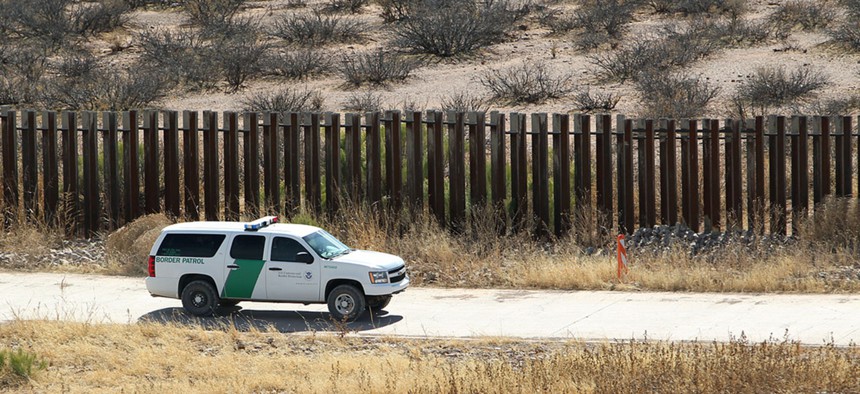
Border Patrol secures border fence line in Arizona in 2011. Customs and Border Protection file photo
Almost 200 Firms Have Bid To Build Trump's Border Wall
More may answer the call when the federal government lists its formal solicitation on March 6.
The federal government’s solicitation for the design and construction of a wall on the U.S. border with Mexico has already drawn interest from nearly 200 construction and engineering firms, just days after the notice first appeared.
Companies from 41 states, the District of Columbia, and Puerto Rico have signaled their interest in being selected to work on President Donald Trump’s proposed southern border wall. As of Monday evening, about 180 different firms had answered the federal presolicitation, which the U.S. Customs and Border Protection agency posted to the Federal Business Opportunities website on Friday.
The list suggests widespread interest in what could be one of the biggest—and most notorious—contracts of any infrastructure project planned by the Trump administration. Building a wall along some or all of the nation’s 2,000-mile-long southern border will require deep experience negotiating complex logistical, legal, and environmental challenges, depending on the scope of the project, about which little is yet known.
Several corporate titans, among them Raytheon, a defense contractor, and Caddell, a construction company with a global portfolio, have expressed preliminary interest in building the wall. Leo A Daly, an international architecture and engineering firm, was one of the more prominent design firms listed. Dozens of companies described themselves as minority owned, veteran owned, or small disadvantaged businesses. Nineteen of the interested vendors are woman-owned companies, and 15 are Hispanic American owned.
The list of interested vendors obtained by CityLab is by no means final. This days-old federal posting is merely a preliminary advertisement; a formal solicitation will be posted on March 6 that will call for concept prototypes, due March 10. From there, the government will narrow down the list of applicants to a set of finalists, who will be required to answer a full request for proposals (RFP), including costs, by March 24.
The extreme haste of the government’s procurement process is matched only by the breakneck speed with which the government plans to build the wall. A Reuters article cites an internal U.S. Department of Homeland Security report as saying that the government aims to finish the wall before the end of 2020.
Not all of the vendors that declared their interest in the project are necessarily up to the task. A cursory review shows that one of the contractors appears to deal in office stationery and school supplies, for example, while another advertises budget infographics. Two are solar-power companies. Another two of the interested contractors appear to be artists—one based in Hamburg, Germany, and another in Alexandria, Virginia—who may be trying to punk the process. The latter listed a corporate name of #ArtThatWall.
But the great majority of vendors seem to be at least relevant. Engineering, design, construction, and project management firms of all different sizes took note of the government’s call. Some 38 companies from Texas alone responded, despite the fact that many Republicans in Texans oppose a border wall. California followed as the state with the next highest number of firms responding to the bid.
Building a wall along the border with Mexico faces a number of significant, maybe impossible obstacles. A national poll conducted early in February found that 60 percent of respondents oppose a border wall, with negatives slowly climbing. Mexico has said that it will not pay for the wall—as Trump promised to force the country to do—and has further pledged to answer any pay-for border tariffs in kind. DHS estimates that a border wall will cost $21.6 billion, while a different (unofficial) estimate is close to twice that amount. Congress hasn’t appropriated any funds for a border wall.
Any company (or companies) picked for the job faces a sincere reputational risk. “No Ban, No Wall” has emerged as a rallying cry for Muslim and Latino communities and their allies at protests held across the nation. The firm that wins the final RFP may also earn undesirable exposure from activists.
The DHS memo authorizing the wall suggested some flexibility in the scope of the project. A wall could potentially resemble the simple fencing that already runs along more than 600 miles of the southern border. Additional border agents or electronic surveillance could contribute to a “wall” that falls short of a steel-reinforced concrete structure.
However, Trump may prove unlikely to yield ground on one of the centerpieces of his presidential campaign. He has consistently described the proposed border wall in grandiose terms. As with the contract to build the F-35 fighter jet, in which the president has personally intervened, a border wall with Mexico may be a project in which Trump cannot resist playing developer-in-chief. He has already invited Jorge Pérez, a former business partner and the head of Related Group, to help build the wall.
Pérez rejected Trump’s offer, calling the wall “the most idiotic thing I’ve ever seen or heard in my life.”
(Amanda Kolson Hurley contributed reporting to this story.)






